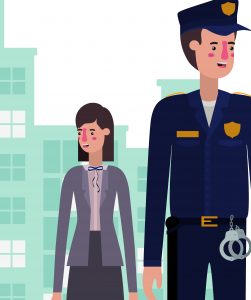Social Work, Criminal Justice Faculty Currently Engaged in Police Education, Research
By David Miller
June 25, 2020
Before Dr. Hee Yun Lee’s full-time career in academia, she routinely worked alongside police officers.
It was the early 2000s, when Lee was a children’s social worker for the Los Angeles County Department of Children and Family Services. There, she and officers investigated cases of potential child abuse and neglect throughout the county.

A team approach: social workers work in tandem with police to investigate cases of abuse and neglect. (Adobe stock)
“It was a team,” Lee said, noting that officers would also accompany her during in-person home and community visits to ensure safety the safety of her and her clients.
Their working relationship is one of the most common examples of how social workers and law enforcement officers work in tandem to serve communities. And, as the wave of police misconduct cases and community distrust grow across the United States, this kind of pairing is foundational for those who champion the “defund police” movement.
However, there are many layers to what defunding police departments entails; the general idea is to divest funds from police budgets to support social service programs, but the concept is often confused with ideas of “dismantling” or “disbanding” departments – more drastic measures that widen the spectrum of potential changes to policy, funding and infrastructure for public safety, which elicit semantic arguments and polarizing responses.
Minneapolis’ city council, following the death of George Floyd, voted to “dismantle” its police department in favor of a “transformative new model of public safety.” Its initial announcement came without a strategic plan for how funding and services would be realigned, nor did it include a timeline for how or when the city would disband its police force, only that the “groundwork is laid already” and that the city will work with community members to assess needs for a new public safety model.
While there is ambiguity in Minneapolis’ plans and a just a handful of examples of other cities fully and successfully disbanding their police departments – Camden, New Jersey, being the most cited – the council has at least addressed an important preliminary step in its quest: community action.
Still, there are significant hurdles to either defunding or disbanding police departments, especially in a broad swoop, because of the “autonomous nature” of local municipalities, said Dr. Diana Dolliver, associate professor of criminal justice at The University of Alabama.
“It’s complicated because of decentralization and each department having separate sovereign boundaries,” Dolliver said. “Departments can act independently of any other county or municipality, setting their own budgets and hiring their own officers.
“Because of this, you can’t have a blanket, nationwide shift [in policing] unless federal laws are passed,” Dolliver added. “And even then, it is up to the individual departments to implement cultural change. The solution has to be local.”
Even the less drastic option of defunding police departments has mixed support among progressive leadership, including 2020 Democrat presidential candidate Joe Biden, who told CBS he doesn’t support defunding police, opting instead to pledge federal aid to improve policing.
Academia’s role
Across the University of Alabama campus, researchers are exploring public safety through a variety of lenses.
Both Lee, associate dean for research and Endowed Academic Chair (health) in Social Work at UA, and Dolliver are leading active research projects that provide training and education to officers in Alabama to address critical components of police reform.

Dr. Hee Yun Lee is leading separate projects that provide mental health training for police officers in Tuscaloosa County, and a tele-health network to combat opioid abuse in rural Alabama counties.
Lee, through a Substance Abuse and Mental Health Services Administration grant, is tailoring mental health training curriculum for officers in each of the nine law enforcement agencies in Tuscaloosa County. The grant also will include the development of a web-based app to help officers de-escalate situations with people with mental health disorders or substance abuse. UA’s Center for Advanced Public Safety, which develops technology for law enforcement and public safety, will create the app.
Lee’s program will include scenario-based education and a comprehensive database of mental health services for referrals.
“Some states already mandate mental health training, and hopefully, in the future, Alabama will do the same,” Lee said. “Officers need these crisis intervention skills.”
Over the last year, Dolliver has worked with University of Alabama police officers to The study began in 2017 with a neurological focus and later added a criminological component, like the use of force continuum, when Dolliver joined in 2019. The goal across both iterations of the study has been to improve officer selection and training.
Additionally, the School of Social Work has also worked with the City of Tuscaloosa to strengthen another vital cog in public safety: emergency medical services. The School partnered with the city in 2016 to reduce the number of non-emergency 911 calls, which saw social work interns work with Tuscaloosa Fire Rescue to assess needs of clients and connect them with services across the county. The program’s success later led to the creation of a full-time coordinator position currently held by a former intern and UA MSW graduate.
The core issues
These research partnerships show how increased education, innovative technology and new ideas can support policing, and how academia can fill the voids at the community level.
However, the “eroding” of social safety nets over the last 40 years reflects deep-rooted, often overlooked correlates of crime that require greater action, according to Dr. Lesley Reid, interim dean for the UA School of Social Work. Reid has researched fear of crime and neighborhood correlates of crime, specifically in public housing.
“The scope of services that are available through a range of agencies and systems, as well as through private and religious entities, pales in comparison to the funding that is behind policing, especially in large cities with large populations of people living in poverty,” Reid said.
Reid says part of the reason for this rapid shift is public sentiment about poverty, and how fear of crime is politicized to support certain agendas. This leads to policies and practices that hinder upward mobility. For instance, revealing prior arrests or convictions when applying for jobs is a barrier to gaining and sustaining income. Additionally, single men face limited options for public housing in large metro areas.
“Who’s going to say we don’t need more police, more safety?” Reid said. “But when the scope of police exceeds the scope of their expertise, we’ve probably gone too far.
“Police aren’t social service providers; they’re not trained for that. But when there’s a dearth of providers or no systems in place, they’re called on to deal with structural situations that they’re not equipped to address.”
A path forward
While Reid would like to see social services better funded to address the connection between poverty and crime, she says there’s no easy fix to make police more responsive to community needs.

UA researchers Dr. Diana Dolliver (left) and Dr. Ryan Cook are studying the reactions of officers in “shoot/don’t shoot” virtual scenarios.
Both she and Dolliver agree that changes to police policies and culture start with chiefs and sheriffs. Reid says there are leaders in policing that share the perspective that the country needs to “think differently” about policing, but they’re in the minority.
A starting point for refocusing for police is establishing more rigorous metrics to determine what works in policing is a good starting point, Reid said.
“We continue to provide funding for policing without asking for the same level of scrutiny like we do, for instance, with education,” Reid said. “Defunding, more accurately, is reallocation, so that police are held to the same level of accountability with their budgets as other state and local agencies, and that the level of their work is outcome driven.”
In addition to the divisive discourse around police conduct, Dolliver warns that decreasing police budgets could exacerbate current issues of recruiting and retaining good officers, which may lead to more of the “wrong types of people” becoming cops.
“Instead of defund, it should be better fund,” Dolliver said. “Policing is significantly underfunded, and people don’t realize how strapped police budgets are unless you are NYPD or LAPD.”
Lee, who is also implementing a tele-health network to combat opioid use in rural Alabama, sees this support through integrating more social workers into police departments. She says it’s not uncommon for police staff to include social workers, but with varying levels of expertise and focus, including more into everyday settings could better inform policy and provide officers real-time professional development.
Lee said she sees her mental health training program leading to departments including a mental health expert on staff.
“There are so many lives gone because of the misunderstanding between officers and clients,” Lee said. “Officers are not as trained as social workers – we’re licensed and trained in how to de-escalate these unique crises. We need to work together to get clients in a safe environment, provide relevant and tailored services and save their lives.”